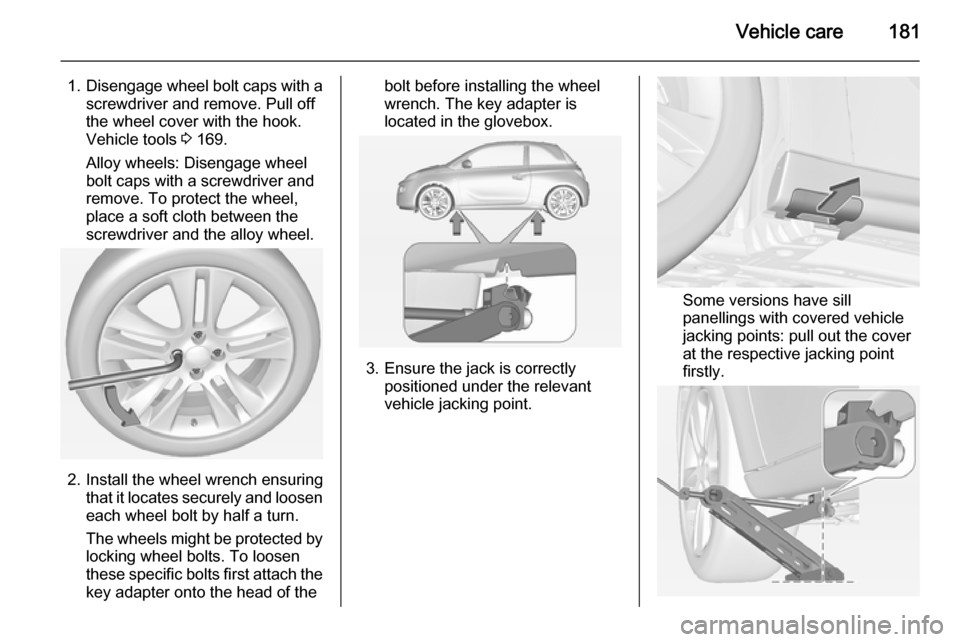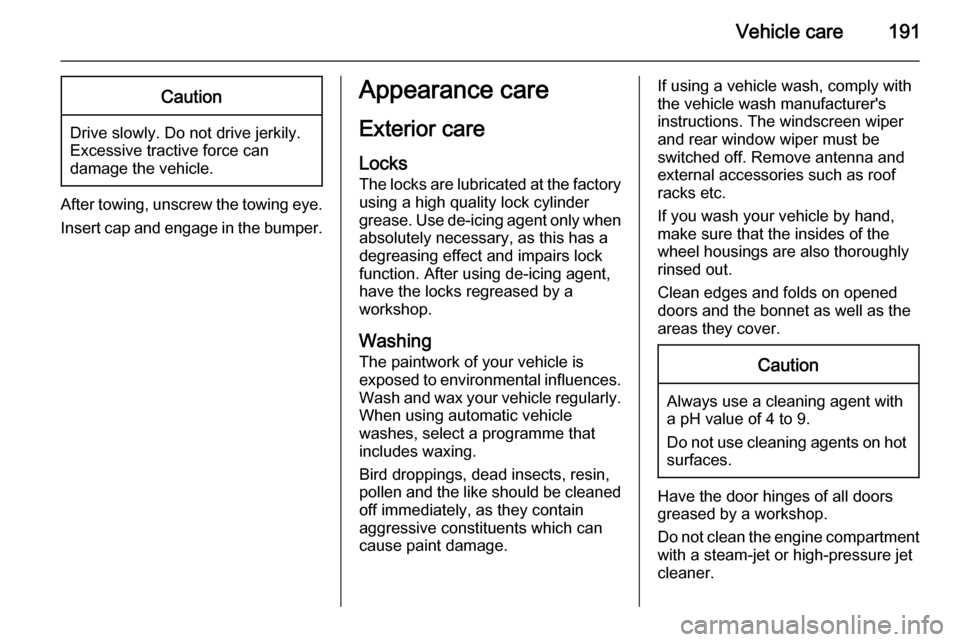lock VAUXHALL ADAM 2014.5 Workshop Manual
[x] Cancel search | Manufacturer: VAUXHALL, Model Year: 2014.5, Model line: ADAM, Model: VAUXHALL ADAM 2014.5Pages: 217, PDF Size: 6.68 MB
Page 183 of 217

Vehicle care181
1.Disengage wheel bolt caps with a
screwdriver and remove. Pull off
the wheel cover with the hook.
Vehicle tools 3 169.
Alloy wheels: Disengage wheel
bolt caps with a screwdriver and
remove. To protect the wheel,
place a soft cloth between the
screwdriver and the alloy wheel.
2. Install the wheel wrench ensuring that it locates securely and loosen
each wheel bolt by half a turn.
The wheels might be protected by
locking wheel bolts. To loosen
these specific bolts first attach the key adapter onto the head of the
bolt before installing the wheel
wrench. The key adapter is
located in the glovebox.
3. Ensure the jack is correctly positioned under the relevant
vehicle jacking point.
Some versions have sill
panellings with covered vehicle
jacking points: pull out the cover
at the respective jacking point
firstly.
Page 185 of 217

Vehicle care183
Front arm position of the lifting
platform at the underbody.
Spare wheel Some vehicles are equipped with a
tyre repair kit instead of a spare
wheel.
If mounting a spare wheel, which is
different from the other wheels, this
wheel might be classified as a
temporary spare wheel and the
corresponding speed limits apply,
even though no label indicates this.
Seek the assistance of a workshop to
check the applicable speed limit.
The spare wheel has a steel rim.Caution
The use of a spare wheel that is smaller than the other wheels or in combination with winter tyres
could affect driveability. Have the defective tyre replaced as soon as
possible.
The spare wheel is located in a holder
beneath the vehicle floor.
1. Open the load compartment floor 3 64.
Remove storage box if equipped
3 62.
2. Remove the wheel wrench from the tool box.
3. Fit the wheel wrench on the hexagon bolt near the tool box
and turn it anti-clockwise until a
resistance is noticeable.
Page 186 of 217

184Vehicle care
4.Lift the spare wheel holder a bit by
hand and unhook the catch.
5. Lower the spare wheel holder.
6. Lift the spare wheel holder a bit by
hand and detach the safety cable.
7. Lower holder all the way and remove spare wheel.
8. Change the wheel 3 180.
The damaged wheel has to be
secured in the load compartment,
see below.
9. Lift the empty spare wheel holder and insert the safety cable.
10. Lift the spare wheel holder farther
and engage in catch. The open
side of the catch must point in the
direction of travel.
11. Close the empty spare wheel holder by turning the hexagon boltclockwise successively using the
wheel wrench.
12. Stow wheel wrench and the jack in the tool box in vehicle floor.
13. Close the load compartment floor.
Stowing a damaged wheel in the
load compartment The spare wheel holder is not
designed for other tyre sizes than the
spare wheel.
A damaged wheel wider than the
spare wheel has to be stowed in the
load compartment and secured with a strap. Vehicle tools 3 169.Wheels with tyre size up to
195/55R16 1. Remove load compartment cover and lift up load compartment floor.
Stow both behind the raised up
backrests of the rear seats.
Page 190 of 217

188Vehicle care
■ Never expose the battery to nakedflames or sparks.
■ A discharged vehicle battery can already freeze at a temperature of
0 °C. Defrost the frozen battery
before connecting jump leads.
■ Wear eye protection and protective
clothing when handling a battery.
■ Use a booster battery with the same voltage (12 Volts). Its
capacity (Ah) must not be much less than that of the discharged
battery.
■ Use jump leads with insulated terminals and a cross section of at
least 16 mm 2
(25 mm 2
for diesel
engines).
■ Do not disconnect the discharged vehicle battery from the vehicle.
■ Switch off all unnecessary electrical
consumers.
■ Do not lean over the battery during jump starting.
■ Do not allow the terminals of one lead to touch those of the other
lead.■ The vehicles must not come into contact with each other during the
jump starting process.
■ Apply the parking brake, transmission in neutral.
■ Open the positive terminal protection caps of both vehicle
batteries.
Lead connection order:
1. Connect the red lead to the positive terminal of the booster
battery.
2. Connect the other end of the red lead to the positive terminal of the
discharged battery.
3. Connect the black lead to the negative terminal of the booster
battery.
4. Connect the other end of the black
lead to a vehicle grounding point,
such as the engine block or an
engine mounting bolt. Connect as far away from the discharged
vehicle battery as possible,
however at least 60 cm.
Route the leads so that they cannot
catch on rotating parts in the engine
compartment.
To start the engine: 1. Start the engine of the vehicle providing the jump.
2. After 5 minutes, start the other engine. Start attempts should be
made for no longer than
15 seconds at an interval of
1 minute.
3. Allow both engines to idle for approx. 3 minutes with the leads
connected.
Page 191 of 217

Vehicle care189
4. Switch on electrical consumers(e.g. headlights, heated rear
window) of the vehicle receiving
the jump start.
5. Reverse above sequence exactly when removing leads.Towing
Towing the vehicle
Disengage the cap by pushing on the
marked position.
The towing eye is stowed with the
vehicle tools 3 169.
Screw in the towing eye as far as it will
go until it stops in a horizontal
position.
Attach a tow rope – or better still a tow
rod – to the towing eye.
The towing eye must only be used for
towing and not for recovering the
vehicle.
Switch on ignition to release steering wheel lock and to permit operation of
brake lights, horn and windscreen
wiper.
Transmission in neutral.
Page 193 of 217

Vehicle care191Caution
Drive slowly. Do not drive jerkily.
Excessive tractive force can
damage the vehicle.
After towing, unscrew the towing eye.
Insert cap and engage in the bumper.
Appearance care
Exterior care Locks
The locks are lubricated at the factory using a high quality lock cylinder
grease. Use de-icing agent only when absolutely necessary, as this has a
degreasing effect and impairs lock
function. After using de-icing agent,
have the locks regreased by a
workshop.
Washing The paintwork of your vehicle is
exposed to environmental influences.
Wash and wax your vehicle regularly.
When using automatic vehicle
washes, select a programme that
includes waxing.
Bird droppings, dead insects, resin,
pollen and the like should be cleaned
off immediately, as they contain
aggressive constituents which can
cause paint damage.If using a vehicle wash, comply with
the vehicle wash manufacturer's instructions. The windscreen wiperand rear window wiper must be
switched off. Remove antenna and
external accessories such as roof
racks etc.
If you wash your vehicle by hand,
make sure that the insides of the
wheel housings are also thoroughly
rinsed out.
Clean edges and folds on opened
doors and the bonnet as well as the
areas they cover.Caution
Always use a cleaning agent with
a pH value of 4 to 9.
Do not use cleaning agents on hot surfaces.
Have the door hinges of all doors
greased by a workshop.
Do not clean the engine compartment with a steam-jet or high-pressure jet
cleaner.
Page 194 of 217

192Vehicle care
On vehicles with emblem touchpad:
when cleaning with a high-pressure
jet cleaner ensure a minimum
distance of 30 cm when working
around the tailgate to prevent
unintended unlocking.
Thoroughly rinse and leather-off the
vehicle. Rinse leather frequently. Use
separate leathers for painted and
glass surfaces: remnants of wax on
the windows will impair vision.
Exterior lights Headlight and other light covers are
made of plastic. Do not use any
abrasive or caustic agents, do not use
an ice scraper, and do not clean them dry.
Polishing and waxing Wax the vehicle regularly (at the
latest when water no longer beads).
Otherwise, the paintwork will dry out.
Polishing is necessary only if the paint
has become dull or if solid deposits
have become attached to it.Paintwork polish with silicone forms a
protective film, making waxing
unnecessary.
Plastic body parts must not be treated
with wax or polishing agents.
Windows and windscreen wiper blades Use a soft lint-free cloth or chamois
leather together with window cleaner and insect remover.
When cleaning the rear window from
inside, always wipe in parallel to the
heating element to prevent damage.
For mechanical removal of ice, use a
sharp-edged ice scraper. Press the
scraper firmly against the glass so
that no dirt can get under it and
scratch the glass.
Clean smearing wiper blades with a
soft cloth and window cleaner.Glass panel
Never clean with solvents or abrasive
agents, fuels, aggressive media (e.g.
paint cleaner, acetone-containing
solutions etc.), acidic or highly
alkaline media or abrasive pads. Do
not apply wax or polishing agents to
the glass panel.
Wheels and tyres
Do not use high-pressure jet
cleaners.
Clean rims with a pH-neutral wheel
cleaner.
Rims are painted and can be treated
with the same agents as the body.
Paintwork damageRectify minor paintwork damage with
a touch-up pen before rust forms. Have more extensive damage or rust areas repaired by a workshop.
Underbody Some areas of the vehicle underbody
have a PVC undercoating while other
critical areas have a durable
protective wax coating.
Page 211 of 217

Customer information209
■ Vehicle reactions in particulardriving situations (e.g. inflation of
an airbag, activation of the stability
regulation system)
■ Environmental conditions (e.g. temperature)
These data are exclusively technical
and help identifying and correcting
errors as well as optimizing vehicle
functions.
Motion profiles indicating travelled
routes cannot be created with these
data.
If services are used (e.g. repair
works, service processes, warranty cases, quality assurance),
employees of the service network
(manufacturer included) are able to
read out this technical information
from the event and error data storage
modules applying special diagnostic
devices. If required, you will receive
further information at these
workshops. After an error has been
corrected, the data are deleted from
the error storage module or they are
constantly overwritten.When using the vehicle, situations
may occur in which these technical
data related to other information
(accident report, damages on the
vehicle, witness statements etc.) may be associated with a specific person -
possibly, with the assistance of an
expert.
Additional functions contractually
agreed upon with the client (e.g.
vehicle location in emergency cases)
allow the transmission of particular vehicle data from the vehicle.Radio Frequency
Identification (RFID) RFID technology is used in somevehicles for functions such as tyre
pressure monitoring and ignition
system security. It is also used in
connection with conveniences such
as radio remote controls for door
locking/unlocking and starting, and in-
vehicle transmitters for garage door
openers. RFID technology in
Vauxhall vehicles does not use or
record personal information or link with any other Vauxhall system
containing personal information.
Page 212 of 217

210IndexAAccessories and vehicle modifications .......................... 150
Adjustable air vents ...................117
Airbag and belt tensioners ...........83
Airbag deactivation ................42, 83
Airbag label................................... 37 Airbag system .............................. 37
Air conditioning regular operation ................................ 118
Air conditioning system .............. 111
Air intake .................................... 118
Air vents...................................... 117
Antilock brake system ................ 125
Antilock brake system (ABS) .......84
Anti-theft alarm system ................24
Anti-theft locking system .............. 23
Appearance care ........................191
Ashtrays ....................................... 76
Automatic anti-dazzle ..................27
Automatic light control ...............103
Automatic locking ........................22
B Battery discharge protection ......109
Battery voltage ............................. 95
Belts.............................................. 34
Bicycle rack .................................. 52
Bonnet ....................................... 152Brake and clutch fluid.................195
Brake and clutch system .............84
Brake assist ............................... 126
Brake fluid .................................. 154
Brakes ............................... 125, 154
Breakdown.................................. 189
Bulb replacement ....................... 157
C Capacities .................................. 206
Car Pass ...................................... 18
Catalytic converter .....................124
Central locking system ................20
Changing tyre and wheel size ...175
Charging system .......................... 83
Child restraint installation locations ................................... 45
Child restraints.............................. 43
Child restraint systems ................43
Cigarette lighter ........................... 76
City mode ................................... 128
Climate control ............................. 15
Climate control systems .............110
Clock ............................................ 74
Code ............................................. 93
Control indicators.......................... 79
Control of the vehicle .................119
Controls ........................................ 69
Convex shape .............................. 25
Coolant and antifreeze ...............195
Page 214 of 217

212
Indicators...................................... 77
Information displays...................... 87
Instrument cluster ........................77
Instrument panel fuse box .........167
Instrument panel illumination .....164
Instrument panel illumination control .................................... 106
Instrument panel overview ........... 10
Interior care ............................... 193
Interior lighting ............................ 106
Interior lights ...................... 106, 164
Interior mirrors .............................. 26
Introduction .................................... 3
ISOFIX child restraint systems ....49
J
Jump starting ............................. 187
K Key, memorised settings ..............20
Keys ............................................. 18
Keys, locks ................................... 18
L
Lashing eyes ............................... 65
Light switch ................................ 102
Load compartment ................22, 61
Load compartment cover .............63
Loading information .....................67
Low fuel ....................................... 86M
Malfunction indicator light ............83
Manual anti-dazzle ......................26
Manual transmission .................. 124
Memorised settings ......................20
Mirror adjustment ........................... 8
Misted light covers .....................106
N New vehicle running-in ..............119
Number plate light .....................163
O
Object detection systems ...........133
Odometer ..................................... 77
Oil, engine .......................... 195, 199
Operate pedal ............................... 84
Outside temperature ....................73
Overrun cut-off ........................... 121
P Parking ................................ 17, 123
Parking assist ............................ 133
Parking brake ............................ 126
Parking lights ............................. 105
Performance .............................. 203
Performing work ........................151
Pollen filter ................................. 118
Power outlets ............................... 76
Power steering.............................. 84Power windows ............................ 27
Puncture ..................................... 180
R Radio Frequency Identification (RFID) ..................................... 209
Radio remote control ...................19
Rear carrier system ......................52
Rear floor storage cover ..............64
Rear fog light ............................... 86
Rear fog lights ........................... 105
Rear storage ................................. 62
Rear window wiper/washer .......... 72
Recommended fluids and lubricants ........................ 195, 199
Refuelling ................................... 146
Retained power off .....................120
Reversing lights .........................106
Ride control systems ..................127
Roof load ...................................... 67
Roof rack ..................................... 67
S
Safety belts ................................... 34
Seat adjustment ....................... 7, 32 Seat belt ........................................ 8
Seat belt reminder .......................82
Seat belts ..................................... 34
Seat folding .................................. 33
Seat position ................................ 31